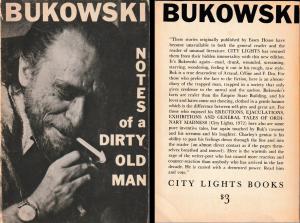Mike Sharon of the The Buk Shop explores how a weekly column in the underground press fueled Charles Bukowski's rise to fame.
CHARLOTTE, NC, UNITED STATES, June 23, 2024 /EINPresswire.com/ -- Published in 1969, this year marks the 55th anniversary of Charles Bukowski's seminal book, "Notes of a Dirty Old Man".
The book is a collection of short stories that appeared in "Open City", a successful weekly tabloid published out of Los Angeles by the legendary John Bryan. Bukowski's column "Notes of a Dirty Old Man" appeared in over 70 issues between 1967-1968 and exposed Bukowski to a much larger audience than the hundreds of little magazines in which he had been published over the previous decade. It's fair to say that this was the point when Bukowski finally became discovered.
The majority of Bukowski's columns were prose in the form of short stories, which attracted people who might outright reject the idea of picking up a book of poetry. In reality, much of Bukowski's poetry was micro short stories composed in stanzas.
Bukowski liked the fact that he could write whatever he wanted in Open City and it would be published just a few days later, rather than the months it took for his work to appear in poetry magazines. Plus, he got $10 a column while the poetry magazines paid little to nothing.
While Bukowski can be credited for helping make Open City a success, he would also play a large role in Open City's demise. As a guest editor of the paper's arts section, Bukowski published Jack Micheline's "Skinny Dynamite", prompting the paper to be charged with obscenity. The resulting legal costs would subsequently force the paper to go bankrupt.
While Open City shut down, the "Notes of a Dirty Old Man" column carried on, appearing in over 200 issues of the Los Angeles Free Press between 1970-1976. The column also appeared in NOLA Express out of New Orleans and was syndicated to publications such as the New York Free Press and Underground Digest.
But the Notes of a Dirty Old Man column reached its ultimate success when it was published in book form. Although most people associate the book with the City Lights edition that came out in 1973, it was first published in 1969 by Essex House.
Essex House was short-lived (1968-1969) publishing imprint based in Los Angeles that specialized in highbrow erotica. A subsidiary of Milton Luros' Parliament News, it was one of the best of many new publishing houses that sprang up after the U.S. Supreme Court finally permitted open publishing of adult fiction. Edited by Brian Kirby, many Essex House novelists were young serious writers who used scenarios drawn from science fiction and fantasy as the basis for their stories.
Interestingly, Bryan was Bukowski's agent in negotiating the publishing deal, which turned out to be an impressive success. Not only did Bukowski receive a $1,000 advance for the book, but Essex agreed to print 28,000 copies, a number that dwarfed any of Bukowski's previous books. The collection featured 40 of Bukowski's previously published columns.
Interestingly, although Essex House published mass market editions, whatever didn't sell was destroyed to make room on the shelves for new books at the retail stores where the books were sold. That's the primary reason why very few copies of the Essex House edition are available today.
Still, the book was profitable enough to catch the attention of Lawrence Ferlinghetti, founder of City Lights Books. While the success of City Lights was built on Beat writers in the 1960s, by the early 1970s the popularity of the genre had died down considerably. Meanwhile Bukowski's popularity was growing quickly, so Ferlinghetti proposed a massive collection composed of the remaining Open City columns as well as other Bukowski magazine appearances.
Although only 5,000 copies of the book were printed when the book was published in April 1972, Erections, Ejaculations and General Tales of Ordinary Madness went on to be a huge success, with many subsequent printings by City Lights. The columns included in this book would also go on to be highly successful in Germany, establishing a profitable foothold in Europe.
Encouraged by its success, the following year Ferlinghetti would purchase the publishing rights to Notes of a Dirty Old Man from Essex House. Like Erections, Ejaculations and General Tales of Ordinary Madness, the book would be a major success for City Lights with many subsequent printings.
Over 55 years later, the City Lights edition continues to sell well and is considered a gateway collection for first-time Bukowski readers.
For more photographs and information on Notes of a Dirty Old Man, visit The Buk Shop.
Michael Sharon
The Buk Shop
+1 704-726-8307
email us here
© 2024 Benzinga.com. Benzinga does not provide investment advice. All rights reserved.
Comments
Trade confidently with insights and alerts from analyst ratings, free reports and breaking news that affects the stocks you care about.


